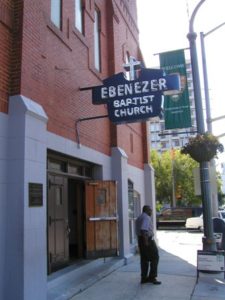(Atlanta, Georgia) –- Auburn Avenue in downtown Atlanta, Georgia, is not a very long street. Despite its short length, however, Auburn Avenue goes a very long way in terms of historical relevance and social meaning.
The name of it may not be as familiar to many people as the events or individuals tied to this avenue. Today, however, a segment of Auburn Avenue is part of one of the most famous and visited National Parks in the United States. Auburn’s extraordinary significance for America and the world draws more than half a million visitors every year.
Walking down on Auburn Avenue can be ordinary for the ordinary, unaware visitor. For a person riding a bus through Auburn –using “Route 3 – Auburn Ave.” of the MARTA —Metropolitan Atlanta Rapid Transit Authority— system, departing from the Five Points Station, the historical landmarks can be easily missed, if not paying attention. Failing to look to both sides of this avenue is a sure way to miss the history, and that is because at first sight, Auburn is not a spectacular avenue.
Auburn Avenue, past greatness and contemporary admiration
Conversely, for those who walk on Auburn conscious and history-sensitive, on an on-foot journey by this remarkable avenue can definitely be a thrill. Knowledge about events, people, and buildings add excitement to the walk; walking adds yet another testimony to the exceptional blending of past greatness and contemporary admiration.
Even with such an amount of noteworthy history, walking by a section of Auburn Avenue –between Courtland Street and the Interstate 75/85 underpass– can be more of a daring or unsafe venture, depending on how you want to see it. The former successful “Sweet Auburn” neighborhood, as the area surrounding this avenue is known, has deteriorated into a zone of crime and neglect –drug dealing, prostitution and muggings– where homeless people wander during the day, and hookers and drug dealers hang out at night.
Many years ago, Auburn was a thriving business corridor of African-American pride. Fortune Magazine once called it “the richest Negro street in the world.” Today, many years later, in the midst of current ambitious redevelopment plans, Auburn’s decay is evident. Walk by this section of Auburn at your own risk.
Located at the northeast corner of Piedmont Avenue and Auburn, the John Calhoun Park –named after a former president of the NAACP Atlanta chapter– houses a group of destitute men whose rough interaction calls attention and attracts police. A man, crouched by the entrance of an old, abandoned building, pretends to be friendly. His friendliness degenerates later into a barrage of insults to the passerby, who just ahead finds relief by looking at a discolored but impressive mural on a store’s side wall.
Passing Jesse Hill Jr. Drive, Bell and Pratt Streets, one finally reaches a dividing point -literally and symbolically- , when the huge shadow created by the underpass of Interstate 75/85 –the Downtown Connector, elevated through Atlanta’s central business district– welcomes you to full blown history.
The underpass is a dark preamble to the bright chapters of history you are about to witness. The stench dominating the area of the underpass is a sure indicator that the homeless people inhabiting under this atmosphere of “privacy” use it as public restrooms. Out of the shadows, a homeless man receives visitors on the sidewalk on the other side of the underpass; he says he knows exactly “Where you’re heading.” With his best smile, he almost convinces you he’s a tourist guide.
Entering the heart of today’s “Sweet Auburn,” the beating of living history is finally heard at the intersection of Jackson Street. There, at the southeast corner of Auburn, a red-brick, three-story building welcomes you, almost unbelievable, to the past: the Ebenezer Baptist Church, a stoic 82-year old structure, a true symbol of the Civil Rights Movement.
At this very spot, the echo of the grave voice of the most prominent leader of the Movement’s era, the Reverend Martin Luther King, Jr., is still audible. There’s nothing virtual or imaginative about this resonance: the thunder-like sound of his famous voice comes from the speakers inside the church –now a museum-like building, where recordings of famous King’s sermons are continuously heard. The effect is chilling; the experience is almost real.

Ebenezer witnessed two generations of Kings preaching from its pulpit. Here, young Martin was baptized, became an assistant pastor; the silent pews testified his funeral, and the violent death of his mother Alberta. Most recently, Ebenezer hosted, in February of 2006, Coretta Scott King’s funeral.
Ushering through a self-guided tour of Ebenezer, the visitor can easily be transported into the past. Coming out of it, and walking eastbound on Auburn, the present comes back, but then, almost unexpectedly, there is, surrounded by a reflecting pool, a white marble crypt: King’s tomb. Located on the grounds of the King Center, King’s burial place is situated right in the middle of Jackson Street and Boulevard. The imposing crypt is flanked by Ebenezer Baptist Church and the King Center, half a block away from the house where he was born.
At this site, Auburn Avenue reveals its unique destiny in African-American history. On this same avenue, within just approximately one thousand feet, Martin Luther King, Jr. was born and raised, worked as an assistant pastor, and was buried. This is truly an amazing and exceptionally meaningful fact binding a remarkable man and an incredible avenue.
This area was designated a National Historic Landmark district on May 5, 1977, and a national historic site on October 10, 1980. The buildings included in this area make up 35 acres. A large visitor center was built to house a museum chronicling the Civil Rights Movement, as well as King’s involvement in it.
In front of Ebenezer Baptist Church, at the northeast corner of Jackson Street, a new and bigger building houses the Ebenezer Baptist Church Horizon Sanctuary, opened on March 7, 1999. The building’s auditorium seats 2000 people. Old and new buildings blend in a full circle of historic magnitude and contemporary importance of a time and struggle for freedom.
Crossing a road simply called Boulevard, the visitor heads to the final destination on Auburn: the Martin Luther King, Jr. birth house, a two-story Queen Anne style house at 501 Auburn Avenue. A tour, conducted by a National Park Service’s ranger, leads you into the fully restored historic house, arranged to be fully furnished to its original appearance when King lived in it. It was in the middle room on the second floor, where the man that would change the course of history was born on January 15, 1929. Thirty-nine years later, King would be buried a few feet away. Auburn thus became a unique stretch in Atlanta and the world, welcoming a boy into history, and giving a martyred man his final resting place.
Auburn Avenue may or may not see an economic boom again; its place in history, however, is more than earned. Walking down its unassuming sidewalks, shared by tourists from around the world, homeless, drug dealers and hustlers, Auburn embraces you from both sides in a breath-taking historic experience.
Walking down on Auburn, ultimately, makes certain that you know that a human struggle for civil rights actually happened. The birth house and the tombstone of a man in such proximity reveal, perhaps, that history can be changed from one’s own street.
© 2006 – 2023, Eduardo Barraza. All rights reserved.





